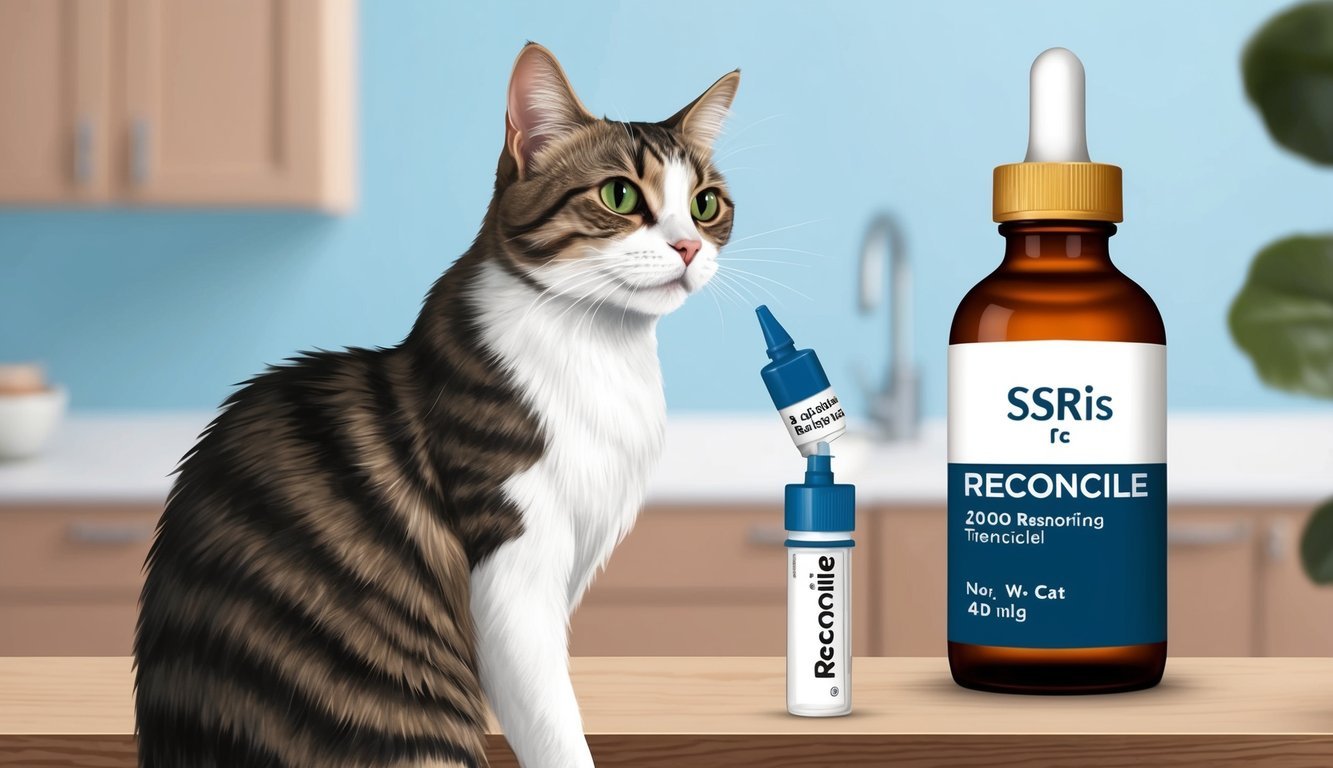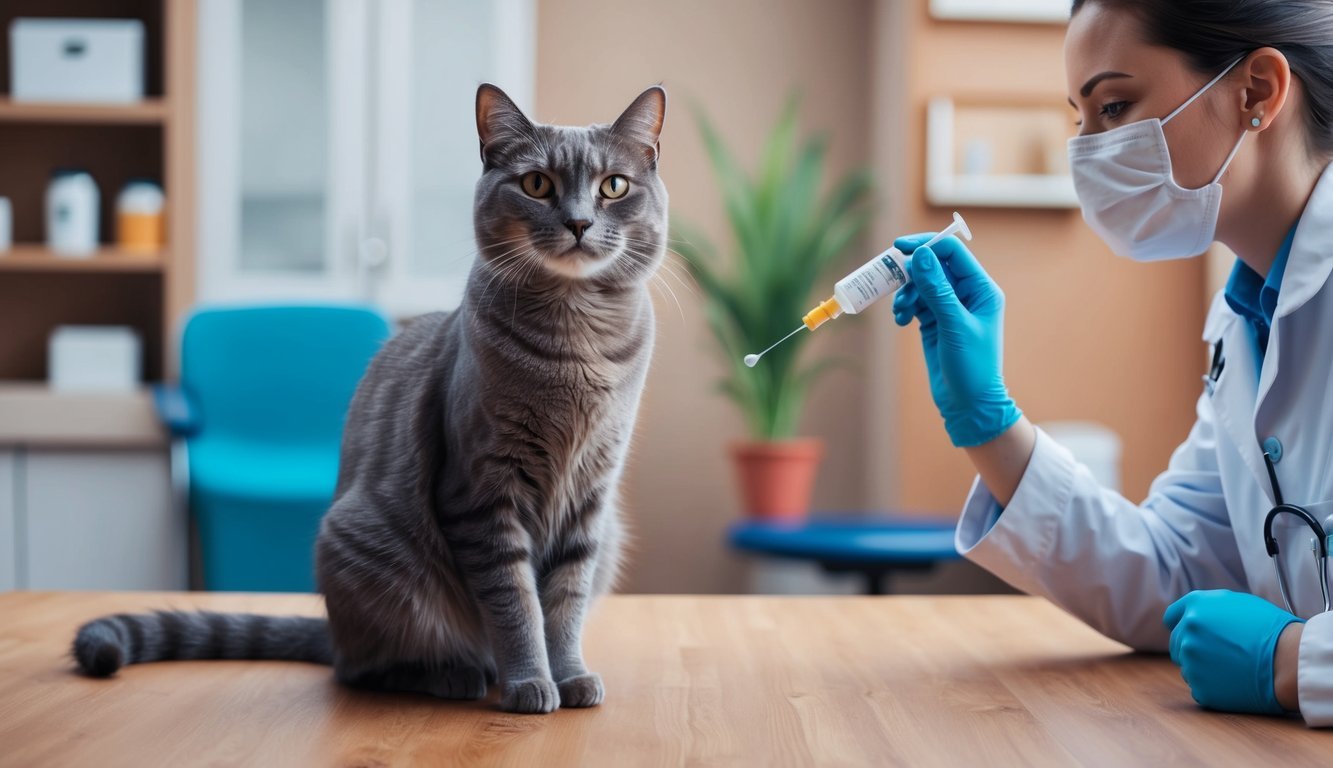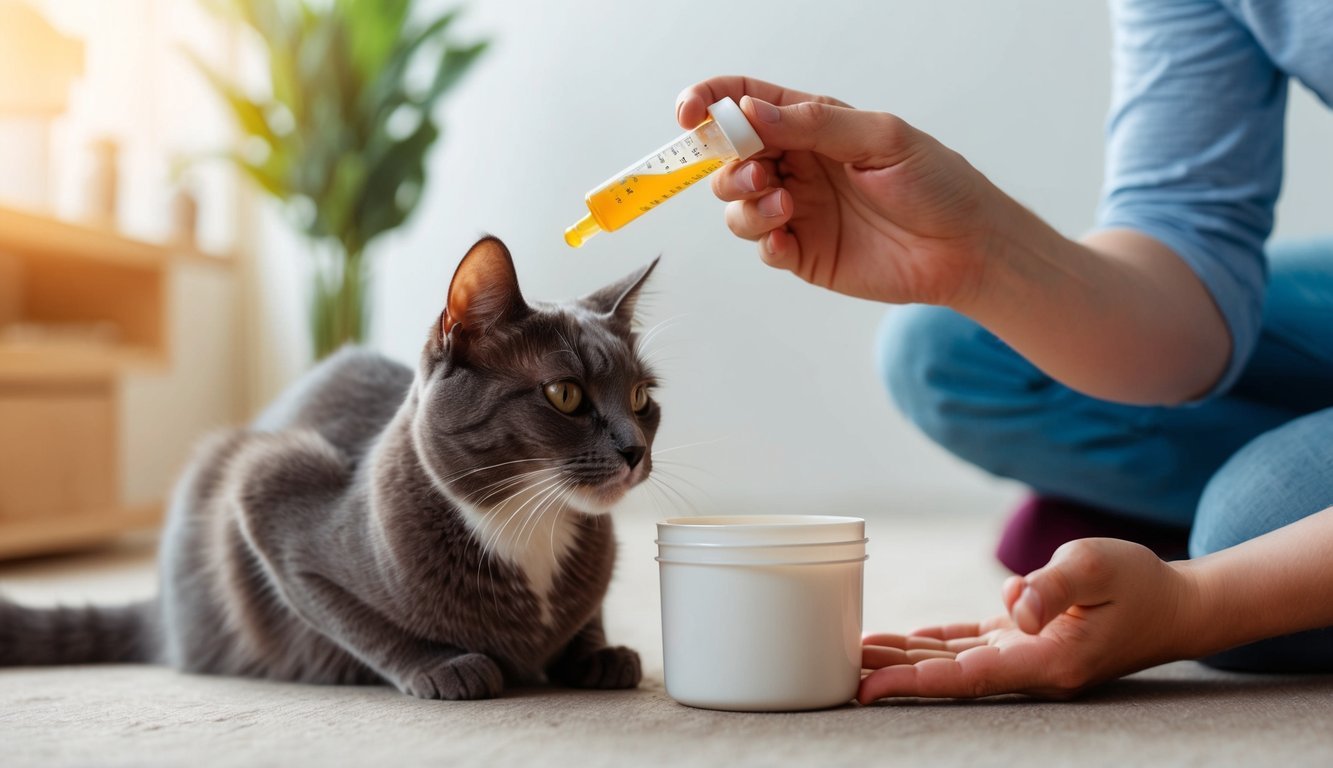If your cat is showing signs of anxiety or behavioral issues, you might feel overwhelmed trying to find the right solution. Reconcile, a selective serotonin reuptake inhibitor (SSRI), has been shown to effectively help manage these troubling behaviors in cats. By increasing serotonin levels in the brain, this medication can assist in calming your feline friend and improving their quality of life.
Many cat owners are turning to Reconcile to address problems like inappropriate urination or aggression.
Veterinary insights confirm that when combined with behavioral modification techniques, Reconcile can lead to significant improvements.
Understanding the right dosage and possible side effects will help you navigate this treatment safely and effectively for your cat.
Before starting any new medication, it’s crucial to consult your veterinarian to ensure it’s the right fit for your pet.
This will open up new avenues for improving your cat’s behavior and overall happiness.
Key Takeaways
- Reconcile can help manage anxiety and behavioral issues in cats.
- Veterinary advice is essential for safe medication use.
- Combining medication with behavioral techniques yields the best results.
Understanding Behavior in Cats

Understanding feline behavior is crucial for ensuring a harmonious environment for both you and your cat.
Recognizing the signs of anxiety, stress, or behavioral disorders can help you address issues effectively and strengthen your bond.
Common Behavioral Disorders in Felines
Cats can display various behavioral disorders.
Some of the most recognized include:
- Aggression: This may stem from territorial disputes, fear, or even pain. Signs include hissing, growling, or swatting.
- Inappropriate Urination: Often a sign of stress or medical issues, this can manifest as urine marking outside the litter box.
- Obsessive-Compulsive Disorders (OCD): You might notice repetitive behaviors, such as excessive grooming or pacing. This can indicate anxiety or boredom.
Understanding these disorders allows you to tailor your approach, particularly if your cat exhibits irritability or frustration.
Identifying Anxiety and Stress Triggers
Cats are sensitive creatures, and various factors can trigger anxiety and stress.
Common triggers include:
- Environmental Changes: Moving furniture, new pets, or changes in routine can upset your cat. Observe how your cat reacts to alterations in their territory.
- Loud Noises: Thunder, fireworks, and loud music can create anxiety. Observe your cat’s behavior during such events to identify triggers.
- Social Interactions: Cats are solitary by nature. If they feel overwhelmed by too much interaction, they may display aggressive or shy behavior.
Recognizing signs of anxiety, like hiding or excessive vocalization, can help you manage your cat’s environment better.
Comparing Feline Anxiety with Canine
While both cats and dogs experience anxiety, their expressions can differ significantly.
- Behavioral Signs: Dogs may bark or chew destructively. In contrast, cats might hide or engage in obsessive grooming.
- Social Responses: Dogs often seek comfort from people when anxious, while cats may retreat.
- Triggers: Both species can be triggered by similar stimuli, like noise or environmental change, but the reactions will vary.
Understanding these differences helps in managing each pet’s needs effectively.
Recognizing your cat’s unique behavior can lead to a more peaceful coexistence.
Introduction to Reconcile and SSRIs

Reconcile is a medication specifically designed for cats that functions as a selective serotonin reuptake inhibitor (SSRI).
This section will delve into how Reconcile operates, its differences from other antidepressants, and an overview of SSRIs.
How Reconcile Works as an SSRI
Reconcile, known generically as fluoxetine hydrochloride, helps manage anxiety and behavioral issues in cats.
By inhibiting the reuptake of serotonin, it increases the amount of serotonin available in the brain.
This process can lead to improved mood and a sense of well-being.
You might notice changes in your cat’s behavior, such as reduced anxiety or less inappropriate urination.
Typically, the effects of Reconcile may take several weeks to become noticeable, which is common for many SSRIs.
Differences Between Reconcile and Other Antidepressants
Reconcile differs from other types of antidepressants in its mechanism and side effects.
Unlike tricyclic antidepressants (TCAs) or monoamine oxidase inhibitors (MAOIs), Reconcile acts specifically on serotonin pathways, making it a go-to option for treating anxiety in cats.
TCAs, for example, can affect multiple neurotransmitters, potentially resulting in more side effects.
In comparison, Reconcile tends to have a more favorable side effect profile, making it easier to manage in pets.
Some common alternatives might include medications like Prozac or Sarafem, which also contain fluoxetine but are formulated for humans.
Selective Serotonin Reuptake Inhibitors Explained
Selective serotonin reuptake inhibitors (SSRIs), including Reconcile, primarily focus on increasing serotonin levels.
This group of medications is commonly prescribed for various behavioral disorders in both humans and animals.
SSRIs work by preventing serotonin from being reabsorbed into the neurons, allowing it to linger longer in the synaptic cleft.
This action is particularly beneficial for conditions like depression, anxiety, or compulsive behaviors.
SSRIs are often preferred for their effectiveness and relatively low incidence of side effects compared to older antidepressant classes.
Veterinary Insight on Reconcile

Understanding how veterinarians view Reconcile can help you make informed decisions about your cat’s behavior issues.
Insights from veterinary medicine shed light on how this medication can be effectively integrated with other treatment strategies.
Consulting a Veterinarian
Before considering Reconcile for your cat, consulting a veterinarian is crucial.
Your vet will assess your cat’s specific behavioral problems and recommend an appropriate treatment plan.
During a veterinary visit, expect a thorough evaluation that may include questions about your cat’s environment and history of the behavior issues. Behavior modification therapy is often recommended alongside medication to achieve the best results.
Your vet may suggest alternatives or additional therapies based on your cat’s unique situation.
Open communication with your veterinarian is key to finding the right balance of treatments.
Veterinary Medicine vs. Human Medicine
While Reconcile is known in human medicine as Prozac, its use in veterinary medicine is specifically formulated for pets.
Veterinary versions, like Reconcile, cater to the unique physiology of cats.
Your veterinarian can explain how dosages differ from those in humans and why it’s crucial to use pet-specific formulations.
Human medications can be dangerous for pets due to differing metabolic rates.
Always follow your veterinarian’s guidance when administering medications to ensure your cat’s safety.
Indications for Prescribing Reconcile
Reconcile is primarily indicated for behavioral problems such as separation anxiety and inappropriate urine marking.
These issues may arise due to stressors in the cat’s environment.
In cats, conditions like compulsive behaviors or aggression may also warrant the use of Reconcile.
It’s often prescribed in conjunction with other strategies, such as behavior modification and, in some cases, neutering.
By addressing both behavioral and environmental factors, your veterinarian can help you create a comprehensive approach to manage your cat’s issues effectively.
Managing Side Effects and Health Considerations

When considering Reconcile for your cat, it’s vital to be aware of the potential side effects and health risks.
You’ll want to stay vigilant for both common and serious symptoms, as well as understand how it may interact with other medications.
Common Side Effects
Your cat may experience various common side effects while taking Reconcile.
These can include:
- Drowsiness: Increased sedation is often reported, which might lead to a more relaxed behavior.
- Loss of Appetite: Some cats may refuse to eat, which can lead to weight loss over time.
- Diarrhea or Vomiting: Gastrointestinal upset is another frequent issue. Watch for signs of nausea too.
- Restlessness or Hyperactivity: While intended to calm anxiety, some cats might show increased anxiety or even agitation.
Monitoring your cat closely during treatment can help address these issues quickly.
If these side effects persist or worsen, consult your veterinarian.
Serious Health Risks and Symptoms
There are serious health risks associated with Reconcile to watch for.
You should be alert for symptoms such as:
- Seizures or Shaking: These may indicate a severe reaction or overdose.
- Depression or Lethargy: While some lethargy is normal, sudden changes in behavior can be concerning.
- Difficulty Breathing: This could signal an adverse reaction and requires immediate attention.
- Signs of Liver or Kidney Disease: Look for increased thirst, changes in urination, or jaundice (yellowing of the skin).
If you observe any of these symptoms, it’s critical to contact your veterinarian right away.
Interactions with Other Medications
Reconcile can interact with certain other medications, making it essential to disclose all medications your cat is currently taking to your vet.
For instance:
- Piroxicam: This non-steroidal anti-inflammatory drug can increase the risk of bleeding or other adverse effects.
- Antidepressants: Combining these can elevate serotonin levels dangerously.
Careful management of any drug combinations can help ensure your cat’s safety.
Always consult your veterinarian to evaluate the risks versus benefits of adding new medications.
Behavioral Modification Techniques
Understanding how to effectively modify your cat’s behavior is essential for improving their quality of life and fostering a harmonious environment at home.
Several techniques focus on training, environmental enrichment, and monitoring progress to achieve desirable outcomes.
Training and Environmental Enrichment
Training plays a significant role in changing behavior. Positive reinforcement is often the most effective method.
When your cat exhibits the desired behavior, reward them with treats or praise.
This encourages them to continue that behavior.
Environmental enrichment is equally important. Interactive toys, scratching posts, and climbing structures can keep your cat engaged and reduce unwanted behaviors born out of boredom.
For instance, a cat that engages in play is less likely to act out due to stress or anxiety.
Creating a stimulating environment can also reduce territorial disputes.
Introduce new scents, toys, and spaces your cat can claim as their own.
Regularly changing their environment can maintain their interest and reduce behavioral issues.
Combining Medication with Behavioral Changes
In some cases, behavioral modifications may not be enough.
When serious problems arise, consulting with a veterinarian might lead you to explore medication options. Anti-anxiety medications or behavior-modifying drugs can help ease your cat’s stress levels.
Combining medication with behavioral training often yields the best results.
Medications can stabilize your cat’s mood, making them more receptive to learning new behaviors.
It’s critical to monitor your cat’s response to any medication and adjust as necessary, ensuring that behavioral techniques complement medical interventions effectively.
Monitoring Behavioral Progress
Tracking your cat’s behavior can help identify what works and what doesn’t. Keeping a behavior journal can be beneficial.
Note the specific behaviors you’re addressing and any modifications you’ve implemented.
Regularly assess your cat’s emotional and behavioral state.
If certain strategies aren’t effective, be ready to adapt your approach.
Your cat’s responses can indicate whether they’re feeling better or if further adjustments are needed.
Consistency is key; maintaining a routine can also help your cat feel more secure, facilitating better behavioral progress.
Dosage and Administration of Reconcile

When considering Reconcile for your cat, knowing the correct dosage and administration is key.
Reconcile, containing fluoxetine, is often prescribed for behavioral disorders like separation anxiety.
Here’s how to ensure your cat receives this medication safely and effectively.
Determining the Correct Dosage
The appropriate dosage of Reconcile for cats typically ranges from 0.5 mg/kg to 1 mg/kg (or 0.25 mg/lb to 0.5 mg/lb).
Most veterinarians may start with 2 to 5 mg per cat once daily.
Make sure to follow your vet’s instructions closely, as individual cats may respond differently.
Consider these factors when determining dosage:
- Weight of your cat: Weigh your cat accurately.
- Severity of condition: A more severe issue may require a higher dose.
- Response to medication: Monitor how your cat reacts and report back to your vet.
Administering the Medication Safely
Administer Reconcile orally, and it’s best to give it with food to minimize stomach upset.
Chewable tablets or capsules are available, making it easier for you to get your cat to take the medication.
Tips for safe administration:
- Make it a routine: Administer at the same time every day.
- Use treats: Hide the tablet in a favorite treat to encourage consumption.
- Watch for side effects: Look out for any adverse reactions like vomiting or changes in behavior.
If your cat refuses the medication, consult your veterinarian for alternatives or dosage adjustments.
Duration of Treatment and Follow-up
The treatment duration with Reconcile can vary based on your cat’s condition and response to the medication.
Often, it may take several weeks to notice significant behavioral improvements.
Regular follow-ups with your veterinarian are essential.
Your vet will assess:
- Effectiveness: Is the medication helping with your cat’s behavioral issues?
- Side effects: Are there any problems that need addressing?
- Dosage adjustments: May the dosage need to be increased or decreased?
Keeping a journal of your cat’s behavior can be valuable for these discussions.
This monitoring allows for tailored treatment that best suits your feline companion.
Understanding Anxiety Related Behaviors

Anxiety-related behaviors in cats can manifest in various ways, often resembling those seen in dogs.
Identifying these signs is crucial for providing the right support.
Let’s explore separation anxiety, therapeutic techniques, and other common anxiety issues that can affect your feline friend.
Separation Anxiety in Cats vs. Dogs
Cats can experience separation anxiety, though it’s often less recognized than in dogs.
If your cat follows you from room to room, this might signal an anxious attachment.
Signs of Separation Anxiety:
- Excessive meowing or whining
- Destructive behavior, like scratching furniture
- Inappropriate urination
While dogs may bark or chew, cats often display more subtle signs.
You might notice a restless demeanor or hidden behavior changes when you prepare to leave.
Understanding these triggers helps you better support your cat’s emotional needs.
Therapeutic Approaches for Anxiety
Addressing anxiety in your cat can involve various therapeutic strategies.
One effective method is using pheromone products.
These come in sprays, collars, or diffusers and release calming scents that help create a comfortable environment.
Another approach is behavioral training.
Gradually acclimating your cat to separations can build their confidence.
For instance, you can start with short departures and gradually increase the time.
This helps them learn that you will always return.
Additionally, interactive toys can engage your cat mentally, reducing anxiety levels.
Mix in puzzle feeders or rotating toys to keep them entertained and distracted during your absences.
Managing Other Anxiety-Related Issues
Cats may show anxiety in different scenarios, such as during thunderstorms or other loud noises.
Thunderstorm phobia can lead to intense reactions, including panting and hiding.
To help, create a safe space with your cat’s favorite blankets and toys.
You can also try calming music or white noise to mask the unsettling sounds.
Monitor for vocalization changes, like increased meowing or unusual whining, as these can signal distress.
Maintaining a consistent routine can ease anxiety, providing your cat with a sense of security.
Remember, patience and observation are key to effectively managing these behaviors.
Frequently Asked Questions

If you’re considering Reconcile for your cat, you probably have some important questions.
Here’s a breakdown of common inquiries regarding its use, side effects, dosage, and more.
What are some common side effects observed in cats taking Reconcile?
Cats taking Reconcile may experience side effects like anxiety, irritability, lack of appetite, diarrhea, and changes in sleep patterns.
More severe effects can include seizures and aggression.
It’s important to monitor your cat for any unusual behavior when starting this medication.
Can Reconcile help with my cat’s aggression issues?
Yes, Reconcile is often used to address aggression in cats.
As a selective serotonin reuptake inhibitor, it can help modulate mood and reduce aggressive behaviors related to stress or anxiety.
This can lead to a more balanced temperament over time.
How long generally does it take for the effects of Reconcile to become apparent in cats?
You may start to notice changes in your cat’s behavior within a few weeks of starting Reconcile.
However, it often takes longer for the full effects to manifest, sometimes up to eight weeks.
Patience is key during this period.
What’s the typical dosage guideline for administering Reconcile to cats?
The dosage of Reconcile for cats typically depends on their size and specific needs.
A common guideline is 1 to 2 mg per kilogram of body weight, administered once daily.
Always consult your veterinarian for personalized dosage recommendations.
Are there any considerations for using Prozac as an alternative to Reconcile for treating cats?
Prozac, which is another name for fluoxetine, is historically used for similar behavioral issues in cats.
While it may be effective, your vet can provide guidance on whether this alternative is suitable for your cat based on their health and specific condition.
Is it safe to administer Fluoxetine to cats, and what are the potential side effects?
Veterinary supervision is essential when administering Fluoxetine to cats.
Fluoxetine is generally considered safe for cats.
Potential side effects include gastrointestinal issues, lethargy, and changes in behavior.
Regular check-ups can help manage any emerging side effects effectively.

